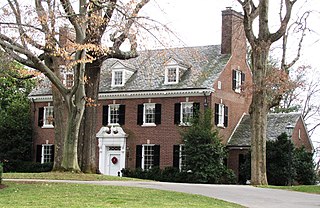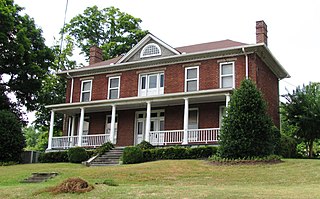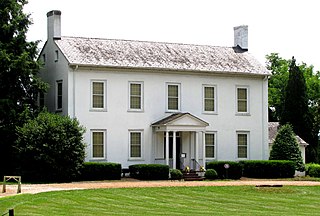
Norris is a city in Anderson County, Tennessee, United States. Its population was 1,491 at the 2010 census. It is included in the Knoxville, Tennessee Metropolitan Statistical Area.

Sevierville is a city in and the county seat of Sevier County, Tennessee, located in eastern Tennessee. The population was 17,889 at the 2020 United States Census.

The Tennessee Theatre is a movie palace in downtown Knoxville, Tennessee. The theater was built in 1928 in the 1908 Burwell Building, considered Knoxville's first skyscraper. The theater and Burwell Building were added to the National Register of Historic Places in 1982, and the theater was extensively restored in the early 2000s. The Tennessee Theatre currently focuses on hosting performing arts events and classic films, and is home to the Knoxville Opera and the Knoxville Symphony Orchestra. The theater is managed by AC Entertainment.

Bleak House is an antebellum Classical Revival style house in Knoxville, Tennessee. It is on the National Register of Historic Places.

The Benjamin Morton House, also known as the Morton-Bush House, is a historic brick home located at 4084 Kingston Pike in Knoxville, Tennessee, United States.

The Samuel McCammon House, also known as James White's House Site, is a historic house at 1715 Riverside Drive in Knoxville, Tennessee, United States. It is on the National Register of Historic Places.

The Blount Mansion, also known as William Blount Mansion, located at 200 West Hill Avenue in downtown Knoxville, Tennessee, was the home of the only territorial governor of the Southwest Territory, William Blount (1749–1800). Blount, a Founding Father of the United States, a signer of the United States Constitution, and a U.S. Senator from Tennessee, lived on the property with his family and ten African-American slaves. The mansion served as the de facto capitol of the Southwest Territory. In 1796, much of the Tennessee Constitution was drafted in Governor Blount's office at the mansion. Tennessee state historian John Trotwood Moore once called Blount Mansion "the most important historical spot in Tennessee."

Middlebrook is a historic house located at 4001 Middlebrook Pike in Knoxville, Tennessee. It was constructed circa 1845 by Gideon Morgan Hazen, and is one of the oldest existing frame residences in Knoxville.

The UTK Agriculture Farm Mound site is an archaeological site on the agriculture campus of the University of Tennessee in Knoxville, Tennessee. The site is a burial mound made by people of the Woodland period, and has been dated as early as ca. 644 AD. Today, the site is a landmark on the UTK campus and is listed in the National Register for Historic Places.

Crescent Bend is a historic home at 2728 Kingston Pike in Knoxville, Tennessee. The building is known as Crescent Bend because of its location on a bend of the Tennessee River. It is also known as the Armstrong-Lockett House, Longview and Logueval.
Glen Craig is a historic home located at 6304 Westland Drive in Knoxville, Tennessee. The land was originally granted to William Lyon. The house was built in 1888 as a summer home of John Craig, Jr., who was married to a daughter of William Lyon.
The Lones–Dowell House is a historic home located at 6341 Middlebrook Pike in Knoxville, Tennessee. Jacob Lones settled on the land in the late 18th century, but the home was not built until circa 1857. The home is generally believed to have been built by Jacob Lones' son, Charles Lones.
This is a list of the National Register of Historic Places listings in Knox County, Tennessee.

The Avery Russell House, also called the Martin-Russell House or the Campbell Station Inn, is a historic home located at 11409 Kingston Pike in Farragut, Tennessee, United States.

The Daniel House is a historic home located at 2701 Woodson Drive in Knoxville, Tennessee. It was designed in 1948–1949 by James W. Fitzgibbon, and constructed by George W. Qualls.

Tennessee marble is a type of crystalline limestone found only in East Tennessee, in the southeastern United States. Long esteemed by architects and builders for its pinkish-gray color and the ease with which it is polished, this stone has been used in the construction of numerous notable buildings and monuments throughout the United States and Canada, including the National Gallery of Art and the National Air and Space Museum in Washington, D.C., the Minnesota State Capitol, as well as parts of the United States Capitol in Washington, Grand Central Terminal in New York, and Union Station in Toronto. Tennessee marble achieved such popularity in the late-19th century that Knoxville, the stone's primary finishing and distribution center, became known as "The Marble City."
Charles Ives Barber was an American architect, active primarily in Knoxville, Tennessee, and vicinity, during the first half of the 20th century. He was cofounder of the firm, Barber & McMurry, through which he designed or codesigned buildings such as the Church Street Methodist Episcopal Church, South, the General Building, and the Knoxville YMCA, as well as several campus buildings for the University of Tennessee and numerous elaborate houses in West Knoxville. Several buildings designed by Barber have been listed on the National Register of Historic Places.
Peter J. Williamson was a Dutch-American architect.

The Lebanon in the Fork Cemetery, also known as Three Rivers Cemetery, is a historic cemetery located at 2390 Asbury Road in eastern Knoxville, Tennessee, U.S..
Jason K. Zachary is a Republican member of the Tennessee State House of Representatives representing District 14 of Knox County.














